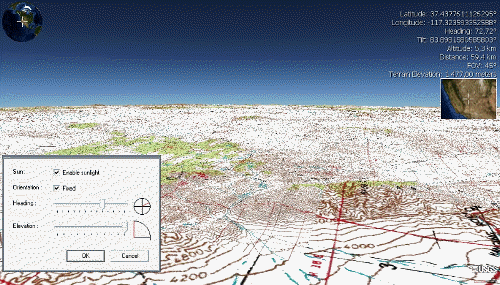|
Tabun-Khara-Obo Crater
Tabun-Khara-Obo is an impact crater in the Dornogovi Aimag (province) the south-east of Mongolia. The crater, which is exposed at the surface, is in diameter. The crater's rim rises some above the crater bottom, but the bottom of crater is covered with up to thick layer of lake deposits - a testimony that this crater in earlier times was filled with a lake. It has an estimated age of 150 ± 20 million years (Middle Jurassic to Early Cretaceous). The site was first identified as a probable impact crater in the 1960s, although confirmation of the hypothesis only occurred decades later. Drilling at the site in 2008 revealed rock features consistent with high-speed impacts such as those caused by meteorites. Image:Tabun-Khara-Obo crater.jpg, Landsat image of the Tabun-Khara-Obo crater; screen capture from NASA World Wind. Image:Tabun-Khara-Obo crater x5.jpg, Oblique Landsat image of Tabun-Khara-Obo crater draped over digital elevation model (x5 vertical exaggeration); screen captu ... [...More Info...] [...Related Items...] OR: [Wikipedia] [Google] [Baidu] |
Middle Jurassic
The Middle Jurassic is the second epoch of the Jurassic Period. It lasted from about 174.1 to 163.5 million years ago. Fossils of land-dwelling animals, such as dinosaurs, from the Middle Jurassic are relatively rare, but geological formations containing land animal fossils include the Forest Marble Formation in England, the Kilmaluag Formation in Scotland,British Geological Survey. 2011Stratigraphic framework for the Middle Jurassic strata of Great Britain and the adjoining continental shelf: research report RR/11/06 British Geological Survey, Keyworth, Nottingham. the Daohugou Beds in China, the Itat Formation in Russia, and the Isalo III Formation of western Madagascar. Paleogeography During the Middle Jurassic Epoch, Pangaea began to separate into Laurasia and Gondwana, and the Atlantic Ocean formed. Eastern Laurasia was tectonically active as the Cimmerian plate continued to collide with Laurasia's southern coast, completely closing the Paleo-Tethys Ocean. A subduction zone ... [...More Info...] [...Related Items...] OR: [Wikipedia] [Google] [Baidu] |
Early Cretaceous
The Early Cretaceous ( geochronological name) or the Lower Cretaceous (chronostratigraphic name), is the earlier or lower of the two major divisions of the Cretaceous. It is usually considered to stretch from 145 Ma to 100.5 Ma. Geology Proposals for the exact age of the Barremian-Aptian boundary ranged from 126 to 117 Ma until recently (as of 2019), but based on drillholes in Svalbard the defining early Aptian Oceanic Anoxic Event 1a (OAE1a) was carbon isotope dated to 123.1±0.3 Ma, limiting the possible range for the boundary to c. 122–121 Ma. There is a possible link between this anoxic event and a series of Early Cretaceous large igneous provinces (LIP). The Ontong Java-Manihiki-Hikurangi large igneous province, emplaced in the South Pacific at c. 120 Ma, is by far the largest LIP in Earth's history. The Ontong Java Plateau today covers an area of 1,860,000 km2. In the Indian Ocean another LIP began to form at c. 120 Ma, the Kerguelen P ... [...More Info...] [...Related Items...] OR: [Wikipedia] [Google] [Baidu] |
Dornogovi Province
Dornogovi ( mn, Дорноговь, ''East Gobi'') is one of the 21 aimags (provinces) of Mongolia. It is located in the southeast of the country, bordering PR China's autonomous region of Inner Mongolia. Dornogovi is located in the Gobi desert and frequent sand- and snow storms amplify the hard weather conditions of Mongolia. Temperatures can range from to with ground temperatures as high as . Dornogovi has ample reserves of groundwater, but no lakes or rivers. Administrative subdivisions * - tosgon (urban-type settlement). ** - The aimag capital Sainshand Sainshand ( mn, Сайншанд; ) is the capital of Dornogovi Province in Mongolia. It is located in the eastern Gobi desert steppe, on the Trans-Mongolian Railway. Administration The territory of Sainshand sum consists of 5 ''bags'' (commune ... References Provinces of Mongolia Gobi Desert States and territories established in 1931 1931 establishments in Mongolia {{Mongolia-geo-stub ... [...More Info...] [...Related Items...] OR: [Wikipedia] [Google] [Baidu] |
Impact Crater
An impact crater is a circular depression in the surface of a solid astronomical object formed by the hypervelocity impact of a smaller object. In contrast to volcanic craters, which result from explosion or internal collapse, impact craters typically have raised rims and floors that are lower in elevation than the surrounding terrain. Lunar impact craters range from microscopic craters on lunar rocks returned by the Apollo Program and small, simple, bowl-shaped depressions in the lunar regolith to large, complex, multi-ringed impact basins. Meteor Crater is a well-known example of a small impact crater on Earth. Impact craters are the dominant geographic features on many solid Solar System objects including the Moon, Mercury, Callisto, Ganymede and most small moons and asteroids. On other planets and moons that experience more active surface geological processes, such as Earth, Venus, Europa, Io and Titan, visible impact craters are less common because they become eroded ... [...More Info...] [...Related Items...] OR: [Wikipedia] [Google] [Baidu] |
Mongolia
Mongolia; Mongolian script: , , ; lit. "Mongol Nation" or "State of Mongolia" () is a landlocked country in East Asia, bordered by Russia to the north and China to the south. It covers an area of , with a population of just 3.3 million, making it the world's most sparsely populated sovereign nation. Mongolia is the world's largest landlocked country that does not border a closed sea, and much of its area is covered by grassy steppe, with mountains to the north and west and the Gobi Desert to the south. Ulaanbaatar, the capital and largest city, is home to roughly half of the country's population. The territory of modern-day Mongolia has been ruled by various nomadic empires, including the Xiongnu, the Xianbei, the Rouran, the First Turkic Khaganate, and others. In 1206, Genghis Khan founded the Mongol Empire, which became the largest contiguous land empire in history. His grandson Kublai Khan conquered China proper and established the Yuan dynasty. After the co ... [...More Info...] [...Related Items...] OR: [Wikipedia] [Google] [Baidu] |
Landsat
The Landsat program is the longest-running enterprise for acquisition of satellite imagery of Earth. It is a joint NASA / USGS program. On 23 July 1972, the Earth Resources Technology Satellite was launched. This was eventually renamed to Landsat 1 in 1975. The most recent, Landsat 9, was launched on 27 September 2021. The instruments on the Landsat satellites have acquired millions of images. The images, archived in the United States and at Landsat receiving stations around the world, are a unique resource for global change research and applications in agriculture, cartography, geology, forestry, regional planning, surveillance and education, and can be viewed through the U.S. Geological Survey (USGS) "EarthExplorer" website. Landsat 7 data has eight spectral bands with spatial resolutions ranging from ; the temporal resolution is 16 days. Landsat images are usually divided into scenes for easy downloading. Each Landsat scene is about 115 miles long and 115 miles wide (or ... [...More Info...] [...Related Items...] OR: [Wikipedia] [Google] [Baidu] |
NASA World Wind
NASA WorldWind is an open-source (released under the NOSA license and the Apache 2.0 license) virtual globe. According to the website (https://worldwind.arc.nasa.gov/), "WorldWind is an open source virtual globe API. WorldWind allows developers to quickly and easily create interactive visualizations of 3D globe, map and geographical information. Organizations around the world use WorldWind to monitor weather patterns, visualize cities and terrain, track vehicle movement, analyze geospatial data and educate humanity about the Earth." It was first developed by NASA in 2003 for use on personal computers and then further developed in concert with the open source community since 2004. As of 2017, a web-based version of WorldWind is available online. An Android version is also available. The original version relied on .NET Framework, which ran only on Microsoft Windows. The more recent Java version, WorldWind Java, is cross platform, a software development kit (SDK) aime ... [...More Info...] [...Related Items...] OR: [Wikipedia] [Google] [Baidu] |
Impact Craters Of Mongolia
Impact may refer to: * Impact (mechanics), a high force or shock (mechanics) over a short time period * Impact, Texas, a town in Taylor County, Texas, US Science and technology * Impact crater, a meteor crater caused by an impact event * Impact event, the collision of a meteoroid, asteroid or comet with Earth * Impact factor, a measure of the citations to a science or social science journal Books and magazines * ''Impact'' (novel), a 2010 novel by Douglas Preston *'' Impact Press'', a former Orlando, Florida-based magazine * Impact Magazines, a former UK magazine publisher * ''Impact'' (conservative magazine), a British political magazine * ''Impact'' (British magazine), a British action film magazine * ''Impact'', a French action film magazine spun off from '' Mad Movies'' * ''Impact'' (UNESCO magazine), a former UNESCO quarterly titled ''IMPACT of science on society'' * ''Impact'' (student magazine), a student magazine for the University of Nottingham, England * ''Bath ... [...More Info...] [...Related Items...] OR: [Wikipedia] [Google] [Baidu] |
Jurassic Impact Craters
The Jurassic ( ) is a geologic period and stratigraphic system that spanned from the end of the Triassic Period million years ago (Mya) to the beginning of the Cretaceous Period, approximately Mya. The Jurassic constitutes the middle period of the Mesozoic Era and is named after the Jura Mountains, where limestone strata from the period were first identified. The start of the Jurassic was marked by the major Triassic–Jurassic extinction event, associated with the eruption of the Central Atlantic Magmatic Province. The beginning of the Toarcian Stage started around 183 million years ago and is marked by an extinction event associated with widespread oceanic anoxia, ocean acidification, and elevated temperatures likely caused by the eruption of the Karoo-Ferrar large igneous provinces. The end of the Jurassic, however, has no clear boundary with the Cretaceous and is the only boundary between geological periods to remain formally undefined. By the beginning of the Jurassic, ... [...More Info...] [...Related Items...] OR: [Wikipedia] [Google] [Baidu] |




